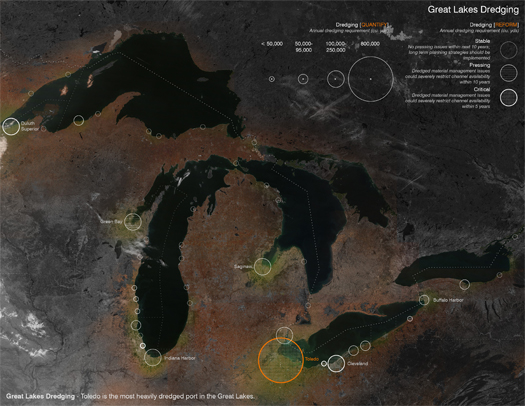
[Map of annual dredging volumes in American cities in the Great Lakes Basin, via Matthew Moffitt’s project “Dredge City”, which won the 2013 ASLA Student Award of Excellence in General Design.]
The city of Toledo is the epicenter of dredging on the Great Lakes: of the roughly three million cubic yards of material dredged in the Great Lakes every year, nearly a full third is sucked out of the Maumee Bay and deposited in disposal areas in and around Toledo.
This rapidly-accumulating surplus is the focus of the first North Coast Design Competition, initiated by fellow dredge fanatic Sean Burkholder. Entitled “Designing Dredge: Re-envisioning the Toledo Riverfront”, the 2014 edition of the competition offers an opportunity to explore the collision of dredged material management and large-scale public space on an urban riverfront, with the specific charge of creating a “dredge research” site, which would host activities like “de-watering experiments, plant growth studies and admixing operations” while “prioritiz[ing] the relationship between dredge material and the public”. (Which I find considerably more exciting than the perhaps more obvious suggestion that landscape architects make a few more parks.) Burkholder recently spoke with Landscape Architecture Magazine‘s Jennifer Reut about the reasoning behind the launch of the competition:
You’ve put the use of dredged material and dredge research sites at the center of the competition’s program. Why?
Dredging in particular is something that does occur in the entire basin, and that’s increasing because of water level recession in the lakes. Shipping is the most cost-effective means of transport in the area, and it continues to be a better option for moving bulk materials. Shipping is not going anywhere, so dredging is not going anywhere. It’s an inevitable condition that needs to be addressed.Toledo is in the shallowest portion of the Great Lakes. Because of that, the shipping channel in Toledo is 20-plus miles long, so imagine what an incredible amount of material that is. The only way of getting ships into the port is continuous dredge… Right now, a dredge research site doesn’t exist. In order to be useful, the material needs to be tested and evaluated, and we need to experiment to see what we can actually do with it. There’s so much of it in Toledo, it makes sense for the experimentation to occur there.
Additional details about the competition, including schedule, requirements, background materials, and jury, can be found on the competition website. Registration opens February 1 and ultimately closes March 30.
[Jennifer Reut also recently interviewed Matthew Moffitt, whose drawing headlines this post, about his project “Dredge City”. Burkholder was Moffitt’s advisor for the project.]

